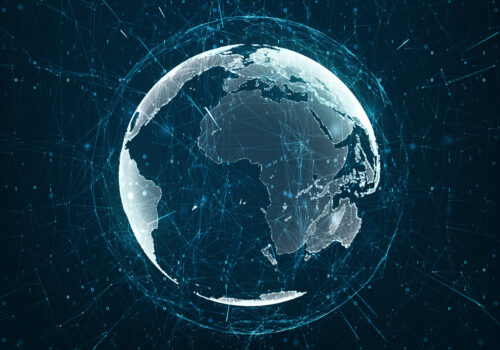By Peter Engelke, Greg Lindsay, and Paul Saffo
Welcome to three possible worlds in the year 2035. As resident and non-resident senior fellows in the Atlantic Council’s foresight practice, we produced these scenarios by assessing how current trends and uncertainties across a variety of categories—including geopolitics, the economy, demography, the environment, technology, and society—might interact with one another in the years to come.
These are not forecasts or predictions of what the future will bring. Instead, these scenarios are intended to inspire imagination and spur readers to consider possible futures, including future worlds that do not align with the readers’ expectations. To paraphrase a sentiment often expressed by the physicist and futurist Herman Kahn, the point of working with future scenarios is to find out what you don’t know and should know but that you didn’t even know you didn’t know.
We invite readers to interpret these scenarios in that spirit. Consider the interplay among the cause-and-effect elements that lead to each of the potential future worlds, as well as the myriad other possible scenarios that could emerge in the years to come.
Perhaps the world of 2035 might vaguely resemble one of the three scenarios presented here, but that is not the central purpose of this exercise. The primary reason why we crafted these scenarios is to generate deeper insights into how today’s actions and inactions might create a better or worse world ten years from now.
Choose your global future
The reluctant international order
Global governance has never been more complicated than it is in 2035. But although the problems are complex, thus far the governance landscape is proving capable of containing at least some of them, as occurred several years ago when we endured a near-miss catastrophe from a bioweapon-fueled pandemic.
We might not be experiencing the halcyon days of a revitalized multilateralism, but thankfully we’re also not inhabiting a kill-or-be-killed nihilistic hellscape. We seem to be living through what some commentators are now calling the “Reluctant International Order.”
Let’s begin with what has not happened: neither the much-feared collapse nor the much-hoped-for revitalization of what often is called the rules-based international order (we’ll use the acronym “RBIO”). Which means that neither the 1930s nor the 1990s have returned.
The international order that the United States and its allies created and maintained after 1945 delivered benefits for decades—benefits that were admittedly partial and often uneven but nonetheless real. Embedded within the RBIO are norms, such as non-aggression toward other countries and respect for human rights, that are laudable ideals. And at its core are multilateral institutions, including the United Nations (UN), World Bank, and World Health Organization (WHO), which were designed to contain conflict, assist with economic development, anticipate and then manage crises of various kinds, and provide some governance in an otherwise anarchic world. The whole order is premised on the notion that international cooperation, combined with the open exchange of ideas and goods, will lead to a better and more peaceful world.
Yet there has long been dissatisfaction with the RBIO. Today, as before, many countries are unhappy with the RBIO and seek to upend or reform it. China and Russia, the two most powerful and vocal of these states, have remained steadfast in their opposition to at least parts of this order, although it also has become clear that their ends are not identical. A decade ago, both began to join with North Korea and Iran to form a grouping that was labeled an “axis of aggressors” because of widespread concern about those countries coordinating to directly challenge the West and the international order, militarily and otherwise. Numerous other countries, often middle and emerging powers in the so-called Global South have sought, at a minimum, to modify the RBIO. These states—with India and Brazil the most prominent examples—have accused the RBIO of being unrepresentative and its defenders of being hypocritical because of their selective application of the order’s underpinning norms. Even the core group of democratic nations that historically defended the order, including the United States, often have acted against the RBIO when it suited their interests.
Resilient rules
Despite all this, the various challenges to the RBIO have never been powerful enough to destroy it. Neither the axis of aggressors nor the partnership between China and Russia ever amounted to real military alliances, reflecting weak rather than strong bonds among them. These revisionist states have acted in disjointed fashion, as a result of their divergent interests, and never staged a coordinated attempt to directly confront the West. Partly for that reason, there has been no global war and thus no wholesale shock that reset the global governance system, as occurred after World War II.
Russia emerged from its war against Ukraine (which ended in a negotiated peace in 2026) far weaker than it was when the conflict began, and it has yet to sufficiently recover to mount another similar challenge westward in Europe. China has made no overt move to seize control of Taiwan either. Evidently, Chinese President Xi Jinping has decided he does not want to gamble his country’s future in a confrontation with the United States, which after all remains a great economic and military power with a formidable nuclear deterrent. (The United States’ increased investment in defense of the Western Pacific also appears to have influenced Xi’s calculations.) It does not help China that Russia is a much-debilitated junior partner.
The case of Taiwan is important for another reason. It underscores that, so far, China and the United States have decided that coexistence is the preferable direction for their relationship, which has prevented the international system from collapsing altogether. Their rivalry has been channeled through other pathways short of war, including diplomatic efforts to curry favor abroad and support for various minilateral and multilateral institutions. And they’ve found, more than occasionally, that their interests actually intersect. In the realm of nuclear nonproliferation, for example, both China and the United States have continued working in tandem to prevent Iran from developing a nuclear weapon, albeit by utilizing very different mechanisms and forms of leverage.
But while the RBIO has not collapsed—meaning there has been no repeat of the era between World War I and World War II—it also has not been revitalized. There has been no return to a triumphalist end of history, no 1990s-style heyday wherein major and middle powers mostly work in concordance with one another toward peaceful and prosperous coexistence within what they perceive as a benign set of global norms and institutions. Hence the increasing references to a “Reluctant International Order,” if meant in jest.
What has happened instead has been an evolution rather than a revolution, characterized more by experimentation and incrementalism than by some jarring disruption. This has occurred because the world’s problems demand coordinated responses even for countries reluctant to do so and because those countries recognize that the opportunity costs of not engaging are so high.
Today, the outward institutional trappings of the RBIO remain in place. The UN continues its work as before, partially because China does not want to destroy it. (The UN’s embrace of state sovereignty, for example, appeals to China’s interests.) Global trade is still growing, despite the tariff wars of the mid-to-late 2020s, owing in part to technological developments that have continued to lower the cost of trade. And the norms underpinning the RBIO haven’t disappeared, either, since many around the world—national and sub-national governments, civil-society and non-profit organizations, grassroots groups and ordinary citizens—want to preserve them and continue to see value in cooperative approaches to transnational problems.
Trading places
Consider trade. More than a decade ago, many nations began curtailing their exposure to global trade flows out of justifiable concern that trade was having detrimental impacts on their security, economies, and societies. Yet despite extensive anti-globalization rhetoric and policies (with the tariff wars the best example), the prevailing perception is that the benefits of trade continue to outweigh the costs. China and the United States, for instance, still have one of the largest bilateral trade relationships of any two countries in the world, despite their now lengthy history of trade disputes, including tariffs and a range of trade restrictions in sensitive technologies.
The leaders of many countries have realized that they have a compelling interest in remaining engaged in trade and talks to increase trade. This has resulted in the creation, maintenance, or expansion of a number of regional free-trade agreements. Several of these efforts have proven quite successful, perhaps best illustrated by the African Continental Free Trade Area (AfCFTA). Over the past fifteen years, African states have joined with the African Union to extend and deepen AfCFTA and, in so doing, to realize several of its longer-term objectives such as the reduction of intra-continental tariffs and loosening of visa restrictions. The case of AfCFTA and others like it—for instance, strengthened trade agreements between the Gulf Cooperation Council countries and Asian countries—underscore that while global trade volume has grown since the mid-2020s, the geography of trade continues to shift.
Nonstate actors have been critical to the maintenance of this system. Multinational companies around the world have made their support for trade well-known, which has helped compel countries to continue defining their interests in pro-trade terms.
Bioweapon-inspired cooperation
Nothing underscored both the value of cooperation and the powers (positive and negative) of nonstate actors like the 2029 bioweapon scare.
That year, a shadowy, transnational doomsday cult—akin to Aum Shinrikyo, which terrorized Japan with sarin gas in 1995—used an artificial intelligence (AI)-enhanced synthetic biology (“SynBio”) process to develop a deadlier and more easily transmissible strain of smallpox. Because the cult’s plot to release it was foiled at the last minute, owing to frantic collaboration among national intelligence services and INTERPOL, the world narrowly avoided a pandemic that would have been far worse than the COVID-19 pandemic.
Horrified by this close call, most of the world’s governments—including the United States, China, and Russia—grasped for solutions. Since pandemics do not respect boundaries, world leaders recognized that there was an upper limit on how much they could protect their people on their own. In response, they quickly sought to deepen collaboration with one another and with leading multilateral public-health institutions such as the WHO, multinational corporations including companies that develop major AI platforms, and the global scientific community that sets standards and runs laboratories. The mandate was clear: Determine how to monitor and regulate the biotechnology space more effectively—or risk perhaps hundreds of millions dying in an AI-enhanced, SynBio-caused (“AIxBio”) pandemic along the lines that the doomsday cult had almost willed into existence.
One of this new coalition’s proposals, which was quickly funded and implemented, was to create an institution similar to the International Atomic Energy Agency but focused on AIxBio. Its formal membership is based on a novel multi-stakeholder model that includes national governments, big-tech firms, and scientific organizations.
The smallpox bioweapon scare vividly illustrated, even for adversarial major powers, the intolerably high risk of countries not engaging with one another through international institutions and on international norms to address the world’s greatest challenges—and on the enduring relevance and value of the RBIO ninety years after its creation. Halting progress in some areas of the international system doesn’t qualify as a renaissance. But even a Reluctant International Order is better than retreat.
China ascendant
Welcome to 2035, and a world whose center of gravity has shifted decisively toward Beijing.
China now has more influence on world affairs than does any other country, including the United States. It is ascendant on every metric of power—diplomatic, military, economic, and technological. That power has enabled Beijing to begin remaking the world to its liking. It has been busy recasting the global system, including multilateral institutions such as the United Nations (UN), in its preferred image, and is in the process of dismantling the democratic norms that have animated the international order since 1945.
China has arrived at this ascendant position in part because the United States has not done much to stand in its way. At the turn of this century, such an outcome would have been impossible to imagine. Even a decade ago, when Washington’s commitment to the rules-based international order showed initial signs of wavering, such an outcome would have been difficult to forecast. But US leaders have been consumed by the challenges of dealing with the country’s weakening economy, fraying societal bonds, and unrelentingly harsh domestic politics. These dynamics have eliminated the longstanding bipartisan consensus around defending the global order that the United States, along with its many allies and partners, had built and maintained for decades.
The result has been that the United States no longer has an unwavering commitment to its allies and partners, the core multilateral institutions at the center of the order that it built, and the norms and principles that it stood behind all those years. Instead, the United States has definitively turned inward. By nearly every metric, the United States remains a major power. But it no longer has much interest in maintaining its leadership role in the world. It has ceded that ground to others, especially to China.
Taiwan-style tipping points
The impact of the US withdrawal from global affairs is evident in various flashpoints around the world, including in Taiwan. While the prevailing fear in the 2010s and early 2020s was of a devastating clash between the United States and China over the island, the Taiwan issue was resolved without firing a shot. China subordinated Taiwan by applying intense pressure—via sabotage, cyber operations, propaganda campaigns, overt and covert influence campaigns within Taiwan, espionage, murky hybrid operations on the island and around its waters—to influence Taiwanese domestic politics toward a cross-Straits settlement with the People’s Republic of China. Its efforts to shape domestic politics within Taiwan succeeded. In 2030, Taiwan’s government agreed to (among other things) such a settlement, which included ceasing defense cooperation with foreign governments and reducing Taiwan’s direct engagement with foreign officials. The United States, which did not respond to China’s various forms of pressure against Taiwan, ultimately could not prevent the cross-Straits agreement, given the Taiwanese government’s support for it. None of China’s individual provocations were dramatic enough for an already hesitant United States to risk a direct military confrontation with China over it.
What happened in Taiwan has also played out on a global scale. There was no one exceptional event or even set of events that triggered a transformation of the international system—no explosion that China engineered to blow up the global order. Thus, there never was a single focal point for China’s rivals—especially the United States—to rally their citizens around and respond to in a coordinated and decisive way. Rather, there has been a gradual and now inexorable shift away from the US-led order and toward a Chinese-led one. This shift resulted from decisions made by both US and Chinese leaders: inward-looking in the case of the former, outward-looking in the case of the latter. It was, in short, a slow-motion fait accompli.
China has positioned itself as the world’s inevitable leader, seizing on its strengths to curry favor with other countries and on the opportunity presented by the United States’ implosion to diminish its rival. Take the performance of the two countries’ economies as an example. A decade ago, the economic outlook was bleaker for China than it was for the United States. But over the past ten years, that script has flipped. In the mid-2020s, Chinese President Xi Jinping managed to right China’s sputtering economy, stabilizing it and returning it to steady growth (if less spectacular growth than during the country’s long boom). He did so by successfully transitioning the country to what many are now calling “an innovation system with Chinese characteristics,” striking a balance of rewarding innovation and entrepreneurialism while maintaining the Chinese Communist Party’s control over the nation’s political apparatus.
All this has enabled China to return to selling itself and its economic rebound on the one hand, plus the United States’ economic stagnation (due to dysfunctional politics) on the other, as a compelling reason why the United States is both unreliable and a poor economic model for the rest of the world, and by extension why China represents a better model. That message has even more resonance around the world now than it did ten years ago.
Because of the pull of China’s growing economy, which remains integrated within global trade flows, plus the relative weakness of the US economy, foreign governments have become more willing to sign onto China’s various economic diplomacy efforts, such as the Global Development Initiative. Beijing now hosts a robust schedule of international economic forums that position it at the center of the economic universe, and thus as the destination for intergovernmental bargaining and influence on issues such as trade and investment. To outside observers, the economic pull of Beijing has eclipsed that of Washington and, for that matter, of Brussels, London, Paris, Seoul, or Tokyo.
As a result, China’s influence has grown in many parts of the world. In the Global South, lower- and middle-income countries in Africa, Latin America, and South Asia (where China remains engaged with India in a long-running contest for influence) have been even more eager to trade with and receive investment from China than they were in the 2020s. This outcome is the product of years (in some cases decades) of aggressive economic diplomacy by China and disinterest from the US government. It also stemmed from reform to China’s overseas lending and investment vehicles, which China recognized needed fine-tuning to make them more palatable abroad and deflect rising criticism of the unsustainable debt and other problems they engendered. Thus far, these policy shifts appear to have worked. China has also become the world’s largest trading nation for both imports and exports, ahead of the United States. Shifting trade in goods also has accelerated movement away from trade denominated in US dollars and toward trade denominated in renminbi—a sure sign of the relative strengths of the two economies.
For China, the advantages are enormous: more wealth at home and influence abroad. China’s diplomatic ties with major materials exporters such as Brazil (soybeans and other crops), the Gulf Cooperation Council states (oil), and the Democratic Republic of the Congo (critical minerals such as cobalt) have increased. For the United States, the reverse has been true. For the average American, wages and incomes have stagnated, and imported goods are more expensive. Abroad, US goods are less competitive in foreign markets than Chinese goods are.
Allies hedging
The United States still has numerous allies and partners, but the bonds that held them together are weaker now than they were in the past owing to the rise of China and the self-induced retreat of the United States.
In Asia, nervous US allies including Japan, South Korea, Australia, and the Philippines are hedging between China and the United States in more ways than they were in the 2020s. But now, having witnessed what happened in Taiwan, these countries are even more concerned about the security guarantee that the United States has provided to them. Both Japan and South Korea have admitted that they are exploring options to acquire nuclear weapons in order to deter China and North Korea, and most analysts expect both to become nuclear-weapons states by 2040. Various forms of US-led minilateral diplomacy in the Asia-Pacific such as the Quad have died slow deaths, the result of both US indifference and Asian countries’ doubts about the value of these efforts to counter and contain a rising China. India, for example, believes it can achieve more through its own bilateral actions to check Chinese influence than it can by working through such forums.
Also contributing to the deep unease of US allies is the growth of China’s military in size and capabilities, and its increasing forward presence in the Asia-Pacific and elsewhere around the world. China has been steadily increasing its number of basing agreements globally to the point where, just as US intelligence services feared a decade ago, China now has bases in Africa, South Asia, the Caribbean, the Middle East, and the islands in the Pacific and Indian oceans.
A similar story is playing out in Europe, albeit focused on a different threat. There, European NATO members are arming themselves rapidly, spending well above the 2 percent of gross domestic product threshold for defense spending that Washington had been requesting for decades. Although that amounts to a victory of sorts for US foreign policy, it really is a defeat because the spending is an expression of serious doubt about the United States’ commitment to NATO and the Alliance’s Article 5 collective-defense pledge should war come again to the continent. Although the previous war in Ukraine ended in a negotiated stalemate, most European observers believe that it is only a matter of time before a rearmed and resurgent Russia decides to test NATO, likely through a long-feared invasion focused on the Baltics.
In this climate, many are pinning their hopes on Beijing rather than Washington, believing that China will restrain Russia, its junior partner, from going on the offensive in Europe. Partly for this reason, and the fact that China is now Europe’s largest trading partner (having surpassed the United States in the early 2030s), European leaders have muted their criticisms of China’s record on human rights, including privacy rights, and have eased China’s access to the common market despite ongoing concerns about dumping, intellectual-property theft, and other such practices.
Institutional shifts
In part because China never has been interested in tearing down the entire international system and replacing it with something else entirely, few Western leaders have paid much attention to how China has been busy recasting these institutions in its image. And indeed, the UN system and the Bretton Woods institutions (the World Bank and International Monetary Fund) continue, with China maintaining its representation in them as it has for decades.
But there have been important changes within the UN system. Recently, for instance, China has been far more successful than it was in previous decades at getting its appointees installed within various technical standard-setting bodies such as the UN’s International Telecommunication Union—a function of China’s unrelenting focus on these specialized bureaucracies plus its rising economic, scientific, and technological prowess.
Or consider the UN’s historic role in maintaining peace and security. China was long willing to support UN peacekeeping operations around the world by providing troops and funds, at least to an extent. Yet with the United States and its democratic allies among the UN Security Council’s five permanent members—France and the United Kingdom—now far less willing to spearhead these operations, China has yet to pick up the leadership mantle. China remains willing to contribute to peacekeeping but generally not to lead large-scale efforts, whether in terms of the Security Council’s broad peacekeeping mandates or the financial, human, and technical resources necessary to build them. The result has been fewer such operations and weaker ones as well, leaving more of the world’s conflicts to devolve and even in some cases metastasize.
Perhaps the most worrisome change has to do with the norms and principles that underpin the global system—both within the UN and more generally as well. Although China expresses support for some of the system’s principles—for example, the UN’s emphasis on state sovereignty and territorial integrity—it manifestly does not support others and especially those based upon democratic values. As a result, serious emphasis on human rights and related norms, as well as global oversight of them, has collapsed within multilateral institutions, including the UN.
These developments are having real, on-the-ground impact. China has successfully built a more robust surveillance apparatus globally that includes more sophisticated cyber-espionage operations capable of tracking the communications of ordinary people around the world, along with a major expansion of China’s overseas police stations. The Chinese government claims that these stations are designed only to service the Chinese diaspora, but their true purpose seems to be to keep track of and pressure both the diaspora and China’s external critics as well.
The erosion of global human-rights enforcement speaks to a broader trend: The so-called democratic recession that has been plaguing the world since the early 2000s is now bordering on a depression. With China ascendant, the world’s autocratic leaders are acting with greater confidence at home and abroad. Midway through the 2030s, the long-running contest between democratic and authoritarian systems appears to be resolving—in favor of the latter.
Climate of fear
In 2035, the Earth’s climate is hotter and less stable than it’s ever been in human history. This instability is causing people to turn on one another—and politics to become more abrasive than it was a decade ago. Climate-driven turbulence is making nearly every other problem—be it geopolitical or conflict-related—harder to solve. These challenges transcend national boundaries and afflict every country, whether rich or poor, to the north or south. Numerous local conflicts and one tense regional standoff (in South Asia) have been fueled by the consequences of a changing climate.
These trends have produced some positive outcomes as well, but in the 2030s it’s difficult to foresee a bright future. As a result, many are looking to radical solutions to get humanity out of its predicament.
Ecological crisis
There is almost no good news to be found in the natural world. A range of climate-induced problems are all worse than they were a decade ago. Observable, on-the-ground environmental changes have consistently outpaced scientists’ predictions from twenty or even ten years ago.
The data indicates that several climate tipping points—including the drying of the Amazon rainforest, the melting of the West Antarctic ice sheet, and the ongoing slowing of the Atlantic Meridional Overturning Circulation system, which regulates temperatures and precipitation in Europe, Africa, and elsewhere—are nearer than we previously thought. Scientists’ modeling, based on real-world data in the 2030s, now points even more strongly toward one or more of these or other critical systems collapsing in the next few decades. When these systems begin to collapse, there will be no practical way back from truly horrific ecological disasters.
Even short of such disasters, the world today lacks the capacity to adjust quickly enough to the climate impacts that are here already. Chronic heat is a problem nearly everywhere in the world, with lengthy heat waves now routine on every continent—including on Antarctica, where record highs, well above freezing, are increasingly common. Most frightening is the rapid increase in “wet bulb” days in some regions near the equator, where high heat plus high humidity make it impossible for humans to survive for long outdoors. Massive storms—flash flooding in the wake of record-breaking torrential rainfall, for example, or hurricanes and cyclones that strike well inland—are commonplace now as well. Several coastal cities around the world, including Bangkok, Miami, and Jakarta, regularly flood, even more frequently than they did a decade ago. In 2029, China’s low-lying Pearl River Delta was hit by a massive typhoon that crippled the region’s manufacturing output for months, disrupting global supply chains.
These developments have numerous second- and third-order consequences. The world’s forests, for example, have become tinderboxes, which means that firefighting has become a significant part of national-security planning for an ever-lengthening list of the world’s governments.
(Geo)political upheaval
Politics and geopolitics are changing with the natural world, largely for the worse. Climate change has weakened the world’s democracies, which already had suffered through decades of decline. From Spain and Greece to South Africa, Nepal, and Panama, storms and suffocating heat waves have disrupted elections by making it harder for some voters to cast their ballots. Such events have also affected who participates in elections in the first place, given how they have influenced the outflows and inflows of people through cities and countries, and the voter registration and verification problems that have followed.
Many years ago, when climate-driven migration was first hypothesized in the scientific literature, few paid attention. Not so today, as fears about the consequences of so-called climate migrants or climate refugees have generated real policies involving real people. These fears often have been based on lurid imagination about crime and chaos rather than on facts.
In 2035, there are an estimated 150 million migrants worldwide who are either temporarily displaced or permanently on the move because of climate impacts, although no one knows the true number because migration is such a complex, multifaceted phenomenon. Yet everyone agrees that more migrants are coming.
Most climate-driven migration remains within national boundaries, often coming in the form of rural-to-urban migration into cities such as Bogotá and Karachi. Or it is intra-regional migration within areas such as Sub-Saharan Africa, the Middle East and North Africa, and South Asia. Such trends are also occurring within wealthy regions and countries such as the United States.
These migration patterns have reminded many of the Syrian crisis of the early 2010s, which was preceded by drought-stressed migrants fleeing the countryside for the cities. Although that internal migration likely was only an indirect cause of the subsequent uprising against the Assad regime—which lasted well over a decade and ultimately resulted in the regime’s overthrow—many now see repetition of that past. They point to how climate-fueled internal displacements have increased recruitment into armed nonstate groups. They note the increasing number of communities around the world where climate impacts have exacerbated preexisting vulnerabilities to cause local conflicts, too many of which have started to become deadly. And they cite the increasing number of failed and failing states resulting in part from climate-driven disasters such as intense, multi-year drought.
Governments have responded through pull-up-the-drawbridges measures—and not just in Europe or the United States, where one might expect that to happen, but around the world, including within the Global South. Border walls designed to keep migrants out were already widespread ten years ago. They are everywhere now.
India, for example, has clamped down on its borders with Bangladesh and Myanmar, heavily fortifying them with more personnel, fencing, sophisticated electronic-surveillance systems, and autonomous enforcement technologies such as drones. Numerous critics, both within India and outside of it, have voiced objections, but the Indian government insists that it is only doing what its voters want. This has led to a volatile diplomatic situation in South Asia. Pakistan, which long ago patched up its relations with Bangladesh, has joined Bangladesh and Myanmar in loudly and publicly pushing India to reverse its border policies, to no avail. The region is not at war, nor is there an immediate risk of one. But it is at a knife’s edge, with climate-driven migration having become one of the biggest sources of friction.
Turbulence-induced transformations
There are some bright spots in this otherwise discouraging picture. Renewables are now firmly established as the world’s dominant sources of energy, reflecting both their market competitiveness and the rapid electrification of the global economy. And nuclear energy has begun making a comeback in much of the world, with the latest reactor designs now seen as safely providing reliable, zero-emission electricity. (New power plants, however, remain rare.) In addition, green-technology markets are expanding rapidly across many industries such as food, water, energy, transportation, and consumer goods. Nearly a third of the world’s stock of cars and trucks is fully electric.
The challenge lies in the rate at which decarbonization is occurring—a pace that simply has not been fast enough. Although global greenhouse-gas emissions finally peaked in the late 2020s, humankind nonetheless surpassed the carbon budget required to stay within the target of keeping global warming above pre-industrial levels to 1.5 degrees Celsius, as laid out in the 2015 Paris Agreement. Scientists had prioritized staying below this target to limit the worst impacts of climate change.
One of the factors contributing to this challenge is that much of the world’s legacy energy infrastructure remains in place. Decommissioning such infrastructure, particularly coal and natural-gas plants, is expensive. Too many of the world’s high-carbon plants still exist, especially coal-fired power plants concentrated in China.
Behind all this is global energy consumption, which has continued to rise fast, consistently outstripping renewables’ capacity to fully meet the demand. (A challenge here is that interest rates for borrowing in riskier storm-affected regions have increased, constraining the expansion of capital-intensive renewables such as offshore wind farms.) There are many drivers of this increasing demand, including technological developments such as advances in artificial intelligence (AI). As was feared in the mid-2020s, the infrastructure necessary to support AI’s growth—in the form of computing power and data centers—boosted global energy demand. Although tech companies have greened their models, the problem is about scale: AI’s ubiquity translates into a massive source of energy usage. Some tech companies have become players in the nuclear-energy space for this reason.
As they navigate this turbulence, and as already foreshadowed in the 2020s, both right- and left-wing populist governments are no longer reflexively hostile to policies to combat climate change like they once were. There is renewed interest in accelerating decarbonization efforts, including revitalizing the moribund United Nations-led process for mitigating climate change.
Another response to the unsustainable status quo has been the embrace of more radical solutions. Geoengineering—and specifically solar radiation modification (SRM), which refers to atmospheric and even space-based efforts to reduce warming by reflecting sunlight back into space—has rapidly gone from a scientific curiosity to a subject of serious research. Although SRM engineering is complex, compared with other approaches it is straightforward and inexpensive. As a result, already in 2035 both state and nonstate actors are experimenting with SRM in the atmosphere. There is great fear that the implementation of these new approaches will be a nightmare, as for-profit companies, tech billionaires, and rogue states initiate their own unilateral solutions, while countries fight over the expected (but dimly understood) impacts on their regions. Although the scientific community is warning that SRM’s consequences aren’t yet sufficiently understood, there is a growing sentiment among many (though not all) politicians that it should be tried at scale. But everyone is asking whether effective geoengineering is even possible without some sort of global governance and regulatory regime.
Meanwhile, the clock is ticking and the climate is changing. Humankind’s efforts to master the natural world during the post-industrial era produced the climate crisis. Now, in 2035, the Earth increasingly seems the master of human affairs rather than the other way around.
About the authors




Global Foresight 2025
In this year’s Global Foresight edition, our experts share findings from our survey of global strategists on how human affairs could unfold over the next decade. Our team of next-generation scholars spot “snow leopards” that could have major unexpected impacts in 2025 and beyond. And our foresight practitioners imagine three different scenarios for the next decade.



